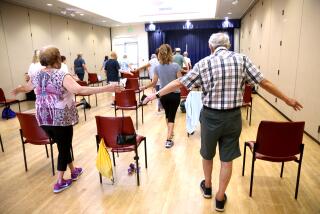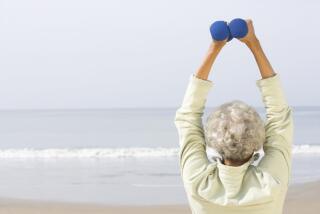They Learn What It’s Like to Be Elderly : Old Becomes New for Aging Doctors
- Share via
Dr. Joseph DiFranza, his hands “arthritic” in thick rubber gloves, his eyesight diminished by dark and blurred glasses, his hearing cotton-impaired, had something of a revelation.
“It was almost impossible to button anything,” he said. “It was so frustrating. It felt like when you were a kid and somebody asked you to do something and you couldn’t do it. If you were younger you might cry.”
DiFranza, 31, was finding out what it feels like to be old. A family practitioner at Burbank Hospital in Fitchburg, Mass., he was participating in a program designed to make hospital physicians and staff more aware of the problems facing older patients and their particular medical needs.
More Patient Now
“I’m much more patient with my elderly patients and elderly people in general now,” DiFranza said. “It’s easy to be patient when you know what it’s like.”
The Burbank program, and many like it across the United States, are attempts by the medical community to deal with a unique and growing population. The elderly, those over 65 years of age, now occupy one-third of all hospital beds. Their numbers will double in the next 35 years.
A few hospitals have devoted entire wings to the care of the elderly, and some have added special teams to consult on geriatric cases, but most cannot afford those sorts of improvements. So many hospitals are trying to improve the resources they do have--their employees.
Sensitivity Program
Every physician and staff member at the Sioux Valley Hospital in Sioux Falls, S.D., is required to attend an “elder sensitivity” program, a 2 1/2-hour presentation providing information about elderly medical needs and the “Myths of Aging.”
In one audio-visual presentation, an elderly man in a hospital bed is seen talking to his daughter. He is obviously alert and communicative. A physician enters the room to discuss the man’s case. He speaks only to the daughter.
“That one really brings the point home,” said Ann Loken, director of Sioux Valley’s Center for Elder Health and Enrichment. “Older people are human beings and should be respected.”
Old Person Kit
Other sensitivity programs vary in methods and complexity, but few are more compelling than the “empathic model” developed three years ago at the Burbank Hospital.
“I thought a fun thing to do would be to make them all old,” said Denise Sevigny, clinical director of gerontology services at the small Massachusetts hospital.
Toward that end, Sevigny developed an old-person kit: two layers of rubber gloves filled with rubberized caulking to simulate arthritis and loss of sensation; sunglasses covered with a plastic sheet to create the dark, blurry world many older people see; cotton wadding to reduce hearing; leg weights to make walking difficult.
Obstacle Course
Once outfitted as older people, Burbank staff members are put through a tortuous obstacle course that consists mainly of “the normal activities of daily living,” Sevigny said.
The newly old find out quickly how difficult it is to open a carton of milk or a child-proof medication container, to unbutton their own clothing or tie their shoes.
“They had us play bingo,” DiFranza recalled. “They gave us these thin poker chips we couldn’t pick up, and then they rattled off numbers we couldn’t hear, and we couldn’t even read the cards.”
“We always try to hurry them along,” Sevigny explained, “because a lot of people who work with the elderly do that and don’t realize that older people can do most of the things we can, they just sometimes need more time.”
Employees Are Amazed
Many of the situations closely parallel those elderly people might encounter in a hospital, allowing staff members an opportunity to evaluate their own behavior.
“We have them sign a consent form with a lot of small print, and a lot of the lines are missing, and we tell them to just read it very quickly and sign it,” Sevigny said. “A lot of the people are surprised to find out how much their handwriting looks like an older person’s.”
More to Read
Sign up for Essential California
The most important California stories and recommendations in your inbox every morning.
You may occasionally receive promotional content from the Los Angeles Times.













